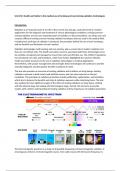Essay
Unit 21C: Health and Safety in the Medical use of Ionising and Non-Ionising Radiation Technologies - BTEC Applied Science
- Module
- Unit 21C
- Institution
- PEARSON (PEARSON)
Unit 21C: Health and Safety in the Medical use of Ionising and Non-Ionising Radiation Technologies - BTEC Applied Science Distinction achieved :)
[Show more]



